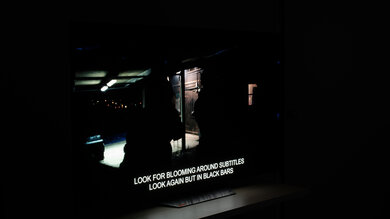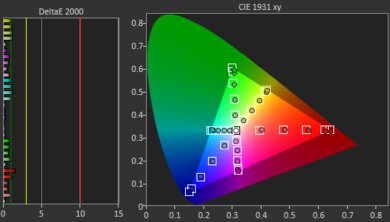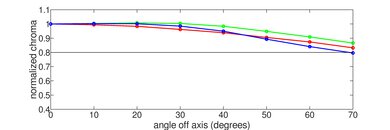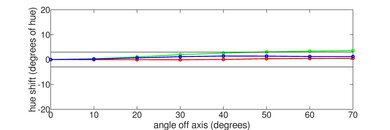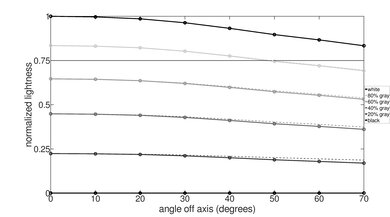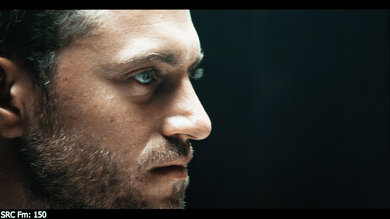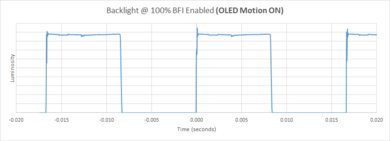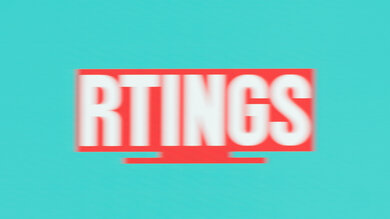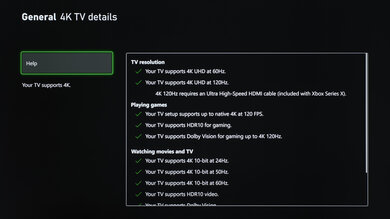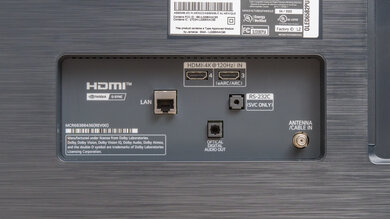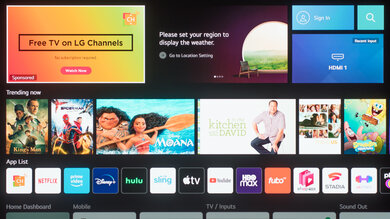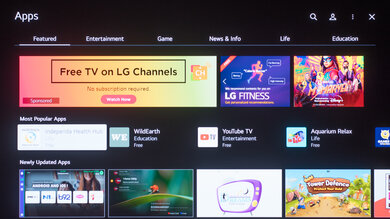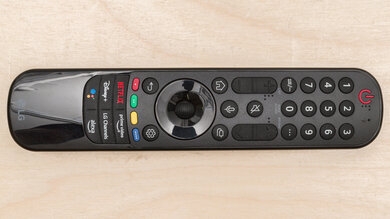The LG B2 OLED is a mid-range OLED TV, replacing 2021's LG B1 OLED. It sits between the LG A2 OLED and the LG C2 OLED in LG's 2022 lineup and is extremely similar to the C2. The main difference is that the B2 has a different processor and uses another type of OLED panel, meaning it doesn't get as bright in HDR as the C2. Still, this TV has a bunch of the same features, like the built-in webOS smart platform that makes it easy to stream your favorite content. It has HDMI 2.1 bandwidth on two ports and supports all variable refresh rate (VRR) formats; AMD FreeSync, HDMI Forum VRR, and NVIDIA G-SYNC. It's also available in a few sizes, from 55 to 77 inches, but it's not available in smaller sizes like the C2.
Our Verdict
The LG B2 is an excellent TV overall. It's remarkable for watching movies in dark rooms thanks to its near-infinite contrast ratio with perfect blacks, and it's also excellent for watching HDR movies, but some colors don't look vivid. If you watch shows or sports in bright rooms, it's impressive as it has incredible reflection handling to fight glare from a few light sources, but it doesn't get bright enough to fight a ton of glare. It's incredible for gaming with HDMI 2.1 bandwidth on two ports, variable refresh rate (VRR) support to reduce screen tearing, low input lag, and a near-instantaneous response time for smooth motion. It's fantastic to use as a PC monitor, but OLEDs risk permanent burn-in when exposed to the same static elements over time.
- Deep and inky blacks.
- Perfect black uniformity.
- Wide viewing angle.
- Risk of permanent burn-in.
- Some colors aren't vivid.
The LG B2 is impressive for watching TV shows in well-lit environments. Its reflection handling is incredible, and it has good SDR peak brightness depending on the content, although it's not bright enough to fight a ton of glare. It also has a wide viewing angle that makes the image look consistent from the sides, just as if you were watching from the front, so you can watch shows with the entire family sitting around the TV with no issues. The built-in webOS smart platform has a ton of apps available to download, and the TV doesn't have trouble upscaling low-resolution content if you watch cable TV. If you use over-the-air signals, it, unfortunately, doesn't support 4k channels.
- Incredible reflection handling.
- Wide viewing angle.
- Some scenes don't get bright enough to fight glare.
- Risk of permanent burn-in.
The LG B2 is amazing for watching sports. Fast-moving players and balls look smooth with minimal motion blur, and it has great gray uniformity that makes playing surfaces look good. It has a wide viewing angle, making it an ideal choice for wide seating areas as people from the side see a consistent image. It has incredible reflection handling if you have a few lights around, but it doesn't get bright with large areas of bright colors, like while watching sports, and it's not enough to fight a ton of glare.
- Incredible reflection handling.
- Wide viewing angle.
- Exceptional motion handling.
- Some scenes don't get bright enough to fight glare.
- Risk of permanent burn-in.
The LG B2 is incredible for gaming. It has many gaming features, like HDMI 2.1 bandwidth on two ports and variable refresh rate (VRR) support, that make it fully compatible with recent consoles and PC graphic cards. It also offers a quick and responsive gaming experience thanks to its low input lag and near-instantaneous response time. Lastly, it's remarkable for dark room gaming as it has a near-infinite contrast ratio that produces deep blacks, and there's no blooming around bright objects either.
- Deep and inky blacks.
- Exceptional motion handling.
- HDMI 2.1 bandwidth.
- Supports all common VRR formats.
- Low input lag.
- Risk of permanent burn-in.
The LG B2 is excellent for watching HDR movies. It looks incredible in dark rooms as it displays deep and inky blacks and has perfect black uniformity without any blooming. It displays a wide color gamut in HDR, but its tone mapping is off, so colors don't look the most accurate. It also has okay HDR peak brightness, enough to make some highlights stand out, but it doesn't get bright enough to deliver a truly satisfying HDR experience with bright and vivid colors.
- Deep and inky blacks.
- Perfect black uniformity.
- Removes 24p judder from any source.
- Small highlights pop.
- Movies appear to stutter.
- Some colors aren't vivid.
- Tone mapping is off.
The LG B2 is fantastic for HDR gaming. It delivers incredible gaming performance thanks to its variable refresh rate (VRR) support, HDMI 2.1 bandwidth on two ports, quick response time, and low input lag. It's also fantastic for dark room gaming because blacks are deep and inky, displaying bright objects without any blooming. Its HDR experience is excellent thanks to its dark room performance, but some highlights don't truly pop, and not all colors look vivid.
- Deep and inky blacks.
- Perfect black uniformity.
- Exceptional motion handling.
- HDMI 2.1 bandwidth.
- Supports all common VRR formats.
- Some colors aren't vivid.
- Tone mapping is off.
The LG B2 is fantastic to use as a PC monitor. Thanks to the low input lag, your mouse movements and keyboard inputs feel responsive, and you won't notice motion blur thanks to the quick response time. It also has a wide viewing angle that makes the image remain consistent if you sit too close, and the reflection handling is incredible if you want to use it in a room with a few lights around. Sadly, OLEDs risk permanent burn-in when exposed to the same static elements over time, like from a PC's user interface.
- Incredible reflection handling.
- Wide viewing angle.
- Low input lag.
- Displays proper chroma 4:4:4.
- Risk of permanent burn-in.
Changelog
- Updated Sep 26, 2025: We uploaded the latest brightness measurements and uniformity photos for the Accelerated Longevity Test.
- Updated Jul 08, 2025: We uploaded the latest brightness measurements and uniformity photos for the Accelerated Longevity Test.
- Updated Apr 17, 2025: We uploaded the latest brightness measurements and uniformity photos for the Accelerated Longevity Test.
- Updated Feb 11, 2025: We uploaded the latest brightness measurements and uniformity photos for the Accelerated Longevity Test.
Check Price
Differences Between Sizes And Variants
We tested the 65-inch LG B2 (OLED65B2PUA), and the results are also valid for the 55 and 75-inch models. Note that the last three letters in the model number (PUA in this case) vary between retailers and individual regions, but there's no difference in performance. Models ending with AUA, like the LG 65OLEDB2AUA, are Costco/Sam's Club variants but are otherwise identical.
| Size | US Model | Europe Model |
|---|---|---|
| 55" | LG OLED55B2PUA | LG OLED55B26LA |
| 65" | LG OLED65B2PUA | LG OLED65B26LA |
| 77" | LG OLED77B2PUA | LG OLED77B26LA |
Our unit of the LG B2 was manufactured in April 2022, and you can see the label here.
Popular TV Comparisons
The LG B2 is an excellent OLED TV. It delivers deep blacks, and it has advanced features for gamers. The B2 is a slight step down from the LG C2 OLED in terms of peak brightness, so if you watch a lot of HDR content, you might want to spend just a bit more for the C2. However, if you don't care about the slight brightness boost and just want the incredible picture quality that OLEDs are known for, the B2 doesn't disappoint.
See our recommendations for the best OLED TVs, the best LG TVs, and the best TVs for movies.
The LG C2 OLED is a higher-end TV than the LG B2 OLED, so it performs better overall. They have the same SDR peak brightness, but in HDR is where the C2 stands out as it gets a bit brighter and highlights pop a bit more. The C2 also has better gradient handling, resulting in less distracting banding while watching HDR content.
The LG B4 OLED is a minor upgrade over the LG B2 OLED. While the B4 does have some upgrades over the older model, namely a slightly brighter panel, improved image processing, and four HDMI 2.1 ports instead of two, they are hardly worth an upgrade, as they are hard to notice. It could also be worth buying the B2 over the B4 if you find the former for a much cheaper price, as you're not losing much by going with the older model.
The LG B3 OLED is the successor to the LG B2 OLED, and while they're both extremely similar, the newer B3 is better in a few ways. The B3 has much better image processing than its predecessor and can pass through advanced DTS audio signals, making it a better option for home entertainment setups. Inversely, the B2 gets brighter in SDR, so SDR content like TV shows and sports pop more on it than on the B3.
The LG C1 OLED and the LG B2 OLED are similar OLEDs. The B2 is the better choice if you need something to use in a well-lit room because it gets brighter in SDR. However, their HDR brightness is similar, and the C1 has better gradient handling, so if you watch HDR content, it's better to go for the C1.

We buy and test dozens of TVs yearly, taking an objective, data-driven approach to deliver results you can trust. Our testing process is complex, with hundreds of individual tests that take over a week to complete. Most of our tests are done with specially designed test patterns that mimic real content, but we also use the same sources you have at home to ensure our results match the real-world experience. We use two main tools for our testing: a Colorimetry Research CR-100 colorimeter and a CR-250 spectroradiometer.
Test Results

After six months, the TV has permanent image retention, easily visible on a 50% gray screen. You can make out the CNN horizontal news ticker bar at the bottom.
The LG B2 TV has a metal back panel, and the part housing the inputs is plastic with a brushed aluminum look. Some of the inputs are side-facing and easy to access with the TV wall-mounted, but the back-facing ones are harder to reach, and you can't make the TV sit flush against the wall if you have cables plugged into the back. Unfortunately, the back-facing ports are the TV's two HDMI 2.1 bandwidth ports.
There's a clip for cable management to help keep your setup clean.
The TV comes with a detachable cable management clip that adds about 0.43" (1.1 cm) to the total thickness, and it means the TV doesn't sit flush against the wall if you wall-mount it. However, you can easily remove it if this bothers you. The above measurements don't include the clip.
The LG B2 has excellent build quality. It's well put together, and there aren't any obvious quality control issues. It has a solid metal back panel, but the plastic portion where the inputs are feels cheap and flexes easily. Despite the stand's small size, it still supports the TV well, and there's only a bit of wobble from front to back.
The LG B2 OLED TV doesn't have a backlight, but thanks to its nearly infinite contrast ratio, it's equivalent to a perfect local dimming feature with no zone transitions. We still film the zone transition video on the TV so you can see how the screen performs and compare it with a TV that does have local dimming.
The TV has decent HDR peak brightness. It's enough to make some small highlights stand out, but its overall HDR experience isn't as good as other OLEDs like the LG C2 OLED. Larger areas of bright colors are noticeably dimmer, so it looks best when there's a small highlight on a dark background.
These measurements are after calibrating the HDR white point with the following settings:
- HDR Picture Mode: Cinema
- OLED Pixel Brightness: 100
- Adjust Contrast: 100
- Peak Brightness: High
- Color Temp: Warm 50
The LG B2 has decent HDR peak brightness in Game Mode, and it looks the same as outside of it. Although the results are slightly dimmer in Game Mode, there's no visible difference.
These measurements are after calibrating the HDR white point with the following settings:
- Picture Mode: Game Optimizer
- OLED Pixel Brightness: 100
- Adjust Contrast: 100
- Peak Brightness: High
- Color Temp: Warm 50
The LG B2 OLED has excellent PQ EOTF tracking. Thanks to its nearly infinite contrast ratio, blacks are perfect, and shadow details are accurately displayed. Midtones are raised slightly from what they should be, but it's not noticeable. As scenes approach the TV's peak brightness, the TV's tracking acts differently based on the content it's displaying; for content mastered at 600 and 1000 nits, which is the majority of content, the TV clips everything above its max brightness, resulting in a loss of fine detail in very bright scenes. For content mastered at 4000 nits, the TV does more gradual tone mapping, preserving fine white details.
The TV has good SDR peak brightness. It's enough to fight glare if you have a few small lights around, but scenes with larger areas of bright colors, like in hockey or basketball, are dimmer due to the Automatic Brightness Limiter (ABL). Even though the TV gets brighter than the LG C2 OLED with the test slides, the C2 is brighter with real content, but the difference isn't too noticeable.
These measurements are after calibration with the following settings:
- Picture Mode: Expert (Dark Space, Night)
- OLED Pixel Brightness: 100
- Adjust Contrast: 85
- Peak Brightness: High
- Color Temperature: Warm 50
Enabling the Peak Brightness setting causes a variation in brightness between different scenes. Disabling it keeps the brightness consistent, but large areas remain dim. You can see the results with it disabled below:
- Peak 2% Window: 322 cd/m²
- Peak 10% Window: 322 cd/m²
- Peak 25% Window: 323 cd/m²
- Peak 50% Window: 322 cd/m²
- Peak 100% Window: 193 cd/m²
- Sustained 2% Window: 305 cd/m²
- Sustained 10% Window: 305 cd/m²
- Sustained 25% Window: 307 cd/m²
- Sustained 50% Window: 304 cd/m²
- Sustained 100% Window: 184 cd/m²
The LG OLED65B2 has an excellent HDR color gamut. It has fantastic DCI-P3 coverage, which is the most common color space used in most HDR content, and has decent coverage of the wider Rec. 2020 color space. However, tone mapping is off with both, resulting in inaccurate colors, especially with green between both color spaces.
The TV has decent color volume. It displays dark and bright colors well, but its incomplete color gamut limits it and can't display colors as bright as pure white. It means that some colors don't look as vivid as they do on the Samsung S95B OLED.
The LG B2 has excellent pre-calibration accuracy in SDR. It displays colors well and has minimal inaccuracies to the white balance. However, the color temperature is on the cold side, giving the image a blue tint, and gamma is slightly off from the 2.2 target for moderately-lit rooms, as most scenes are a bit too dark.
The TV has incredible accuracy after calibration to the D65 white point. It's easy to calibrate thanks to the already-excellent pre-calibration accuracy, and you won't have any issues with the image accuracy.
You can see our full calibration settings here.
The LG B2 has great gray uniformity. The screen is uniform throughout, and there isn't any noticeable dirty screen effect in the center, which is good for watching sports or using it as a PC monitor. It doesn't have a pink tint like the LG C2 OLED, likely because it uses a different type of OLED panel. Like any OLED, there are faint vertical lines in near-dark scenes, but they're hard to notice unless you look for them.
The TV has a remarkable viewing angle. Although colors start to shift at really wide angles, the image remains consistent as you start to view it off-center, making this a fantastic choice for wide seating areas.
The LG 65B2 has incredible reflection handling. It handles even strong light sources well, so you won't have many issues using it in a bright room unless you have a full-screen webpage open or if you're watching sports because the screen gets dimmer when bright objects take up most or the entirety of the scene.
The TV has decent gradient handling in HDR. Transitions from dark to bright shades are smooth for the most part, but there's a bit of noticeable banding on shades of gray and green.
The TV has mediocre sharpness processing with low-resolution or low-bitrate content. The text is a bit blurry and hard to make out, and fine details are lost.
The optimal sharpness settings for low-resolution or low-bitrate content, with no over-sharpening, are as follows:
- Adjusted Sharpness: 20
- Super Resolution: High
The LG 65B2 uses an RWBG subpixel layout, and all four pixels are never on simultaneously. You can see the green and red pixels here and the blue and green pixels here. Note that this TV's subpixel layout causes issues with text display on Windows, as ClearType isn't well adjusted to non-RGB subpixel layouts.
The TV has a near-instantaneous response time resulting in almost no motion blur behind fast-moving objects. However, there's still persistence blur due to the sample-and-hold nature of OLED panels. There's some overshoot in almost-black scenes, but it's not noticeable.
This TV has an optional black frame insertion feature (BFI) that reduces the appearance of persistence blur caused by the TV's extremely fast pixel response time. It only flickers at 60Hz, which is disappointing if you play 120Hz games and want to use the BFI feature. BFI also reduces the TV's brightness, which is very noticeable in practice.
The TV can interpolate low frame rate content up to 120 fps. Like most TVs, it works well with slower scenes but struggles to keep up with fast-paced content. It doesn't stop interpolating even when the action gets busy, but it doesn't look as bad as other TVs.
Due to the quick response time, low frame rate content appears to stutter as each frame is held on longer. Enabling the motion interpolation feature can help reduce the stutter.
The TV automatically removes 24p judder from any source, which helps with the appearance of motion in movies.
The TV supports all of the common variable refresh rate (VRR) formats, and they work without any issues for a nearly tear-free gaming experience. It supports Low Framerate Compensation (LFC) when the frame rate drops below 40 fps, but the minimum VRR range is 40 fps on devices that don't support LFC, like the PS5.
The TV has very low input lag for a quick and responsive feel. Setting Prevent Input Delay to 'Boost' helps ensure the lowest input lag possible in Game Mode, even with variable refresh rate (VRR) enabled. However, if you have the BFI feature enabled, you need to leave Prevent Input Delay to 'Standard', which increases the input lag.
The TV displays any common signal up to 4k @ 120Hz on HDMI ports 3 and 4. It displays proper chroma 4:4:4 with all its supported resolutions, which helps make text look clear when using the TV as a PC monitor. HDMI 1 and 2 are limited to HDMI 2.0 bandwidth, so they can't fully utilize the TV's capabilities.
The TV has no issues using the PS5 to the best of its capabilities, although you need to connect your console to one of the two HDMI 2.1 bandwidth ports if you want to use the console's most advanced features, like 4k @ 120Hz.
The LG B2 OLED has no issues using the Xbox Series X|S to their full capabilities, although you need to connect your console to one of the two HDMI 2.1 bandwidth ports if you want to use the console's most advanced features, like 4k @ 120Hz.
The TV has two HDMI 2.1 bandwidth ports, but one of them also doubles as the eARC/ARC port. That means that when a soundbar is connected to the TV, you only have one HDMI 2.1 bandwidth port left for your high-speed devices. Sadly, the tuner only supports ATSC 1.0, so you can't use it for over-the-air 4k channels.
Unlike the LG B1 OLED, the LG B2 OLED doesn't have an analog audio output, so you can't connect wired headphones or external speakers that use a 3.5mm plug.
You can pass high-quality, uncompressed Dolby Atmos audio to a compatible receiver, but the TV doesn't support DTS or DTS:X passthrough. It's disappointing because many Blu-rays use this audio format. Its successor, the LG B3 OLED, does support advanced DTS audio formats.
The LG B2 OLED has a decent frequency response. It's good enough for the dialogue to sound clear and bright, but you need a dedicated subwoofer to have the best sound experience with proper bass.
The distortion handling is okay. There isn't too much distortion at moderate listening levels, but it gets more noticeable at its max volume.
The TV has a newer version of the LG webOS interface than the LG B1 OLED. It now supports user profiles, meaning you can customize it for each person in your household, and it's easy to use. LG advertises it as webOS 22, but the TV reports itself as using version 7.1.0. Even though it uses a different processor than the LG C2 OLED navigating through the interface feels similar.
The LG Magic Remote has a point-and-press feature that makes it easy to navigate through the menu, like a Nintendo Wii remote. The built-in mic allows you to ask it to change inputs, open apps, and search for content. Unlike the LG C2 OLED, it has no mic built into the TV for hands-free control.










